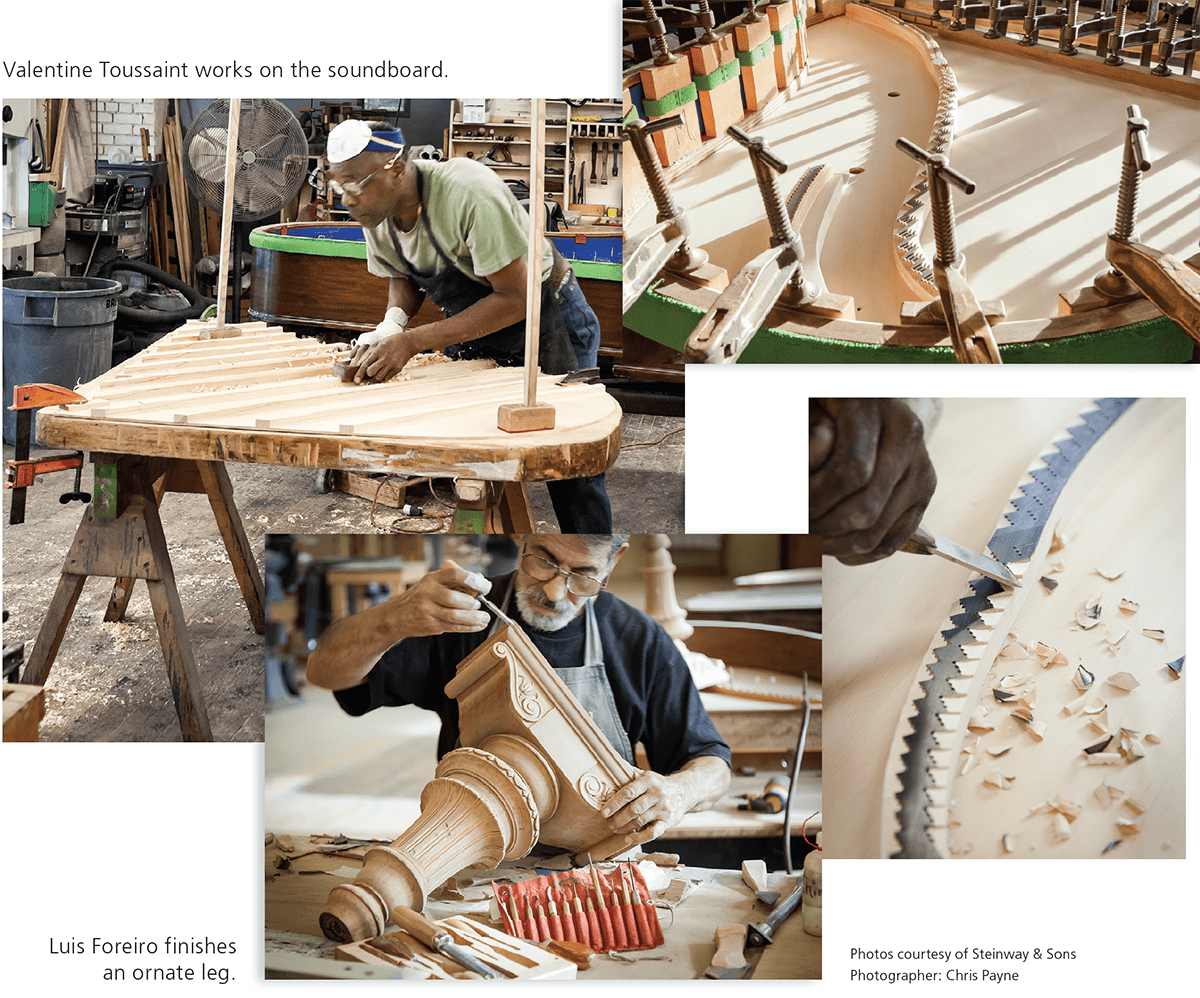
While many of those older pianos are still in use, many others have or soon will have reached the end of their useful life, and will need rebuilding if their owners — families, churches, schools, museums, and universities — want to continue to use them as musical instruments. To serve that need, the piano-building tradition of a century ago lingers on in the many fine rebuilding shops of present-day New York.
Rebuilding a piano — restoring it to like-new condition by replacing its strings, pinblock, action, keys, soundboard, and bridges, and refinishing its case — is a long and complicated process. Further complicating this process is the possibility that the original manufacturer may no longer be in business and therefore is unable to supply parts or materials. If you can, envision craftspeople at work, puzzling over missing parts, re-creating mechanisms of bygone eras, and tirelessly researching and reproducing some of the 19th and early 20th centuries' most complicated musical cabinetry.
I contacted a number of New York–area rebuilders and asked them questions about their history, their operations, and the sources of some of their parts and materials. I also requested that they send me stories and photographs of interesting rebuilding projects they've undertaken, and to display the variety of work being done in their shops.
Here, in alphabetical order, are responses from some of the best-known New York rebuilders:
AC Pianocraft
42-24 Orchard Street, 4th Floor
Long Island City, New York 11101
718-361-9112
www.acpianocraft.com
AC Pianocraft has been rebuilding pianos since 1966, using methods learned by founder Ted Kostakis and his associates while working for many years at the Steinway & Sons factory, also located in Long Island City. Current owner Alex Kostakis, Ted's son, has continued rebuilding fine pianos for institutions and private clients using traditional materials and methods.
His years of being in the trade have given Alex many colorful stories of clients and pianos. While AC Pianocraft's specialties are pianos from Steinway, Mason & Hamlin, and other fine brands, they don't shy away from tackling the more interesting and challenging rebuilds of lesser makes.
The company recently took in for rebuilding a piano by Kranich & Bach, an old New York company that made pianos with lovely art cases, but had actions that were notorious for never working well even when new. Alex said that he at first tried to discourage the owner from having the work done because of the potential for an unsatisfying outcome. But when the customer decided to proceed, Alex ordered sample parts from many manufacturers, trying and modifying them until he came up with a solution. Ultimately, he completely redesigned and installed a new performance-quality action in the spectacular case for a very happy customer.
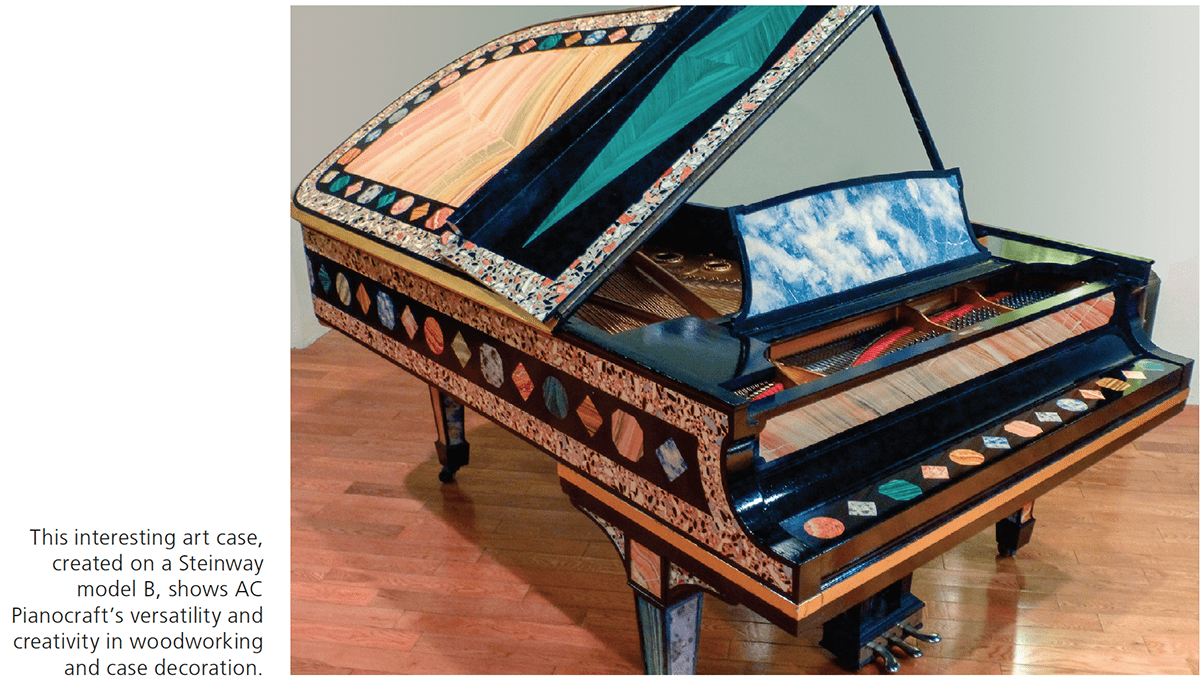
Beethoven Pianos
211 West 58th Street
New York, New York 10019
212-765-7300, 800-241-0001
www.beethovenpianos.com
Offering a wide range of prices and brands, and with a rebuilding facility in the Bronx, Beethoven Pianos has been a fixture in the New York piano market for over 40 years. Owner Carl Demler says that although he does many rebuilding jobs for clients, most of his rebuilds of Steinway, Mason & Hamlin, and European pianos are for resale. In addition, he sells new pianos by Grotrian, Hailun, Ritmüller, and Sauter, among other brands. Demler says he uses only German-made Renner action parts in his rebuilds, but with New York Steinway hammers in the Steinways. Soundboard wood is sourced from a number of countries, depending on which will work best in a particular instrument. In addition to standard case styles, Beethoven specializes in rebuilding art-case pianos. With 10 employees, Beethoven rebuilds about 75 pianos a year. Demler emphasized his attention to detail and reliance on traditional techniques for Beethoven's continued success over four decades.
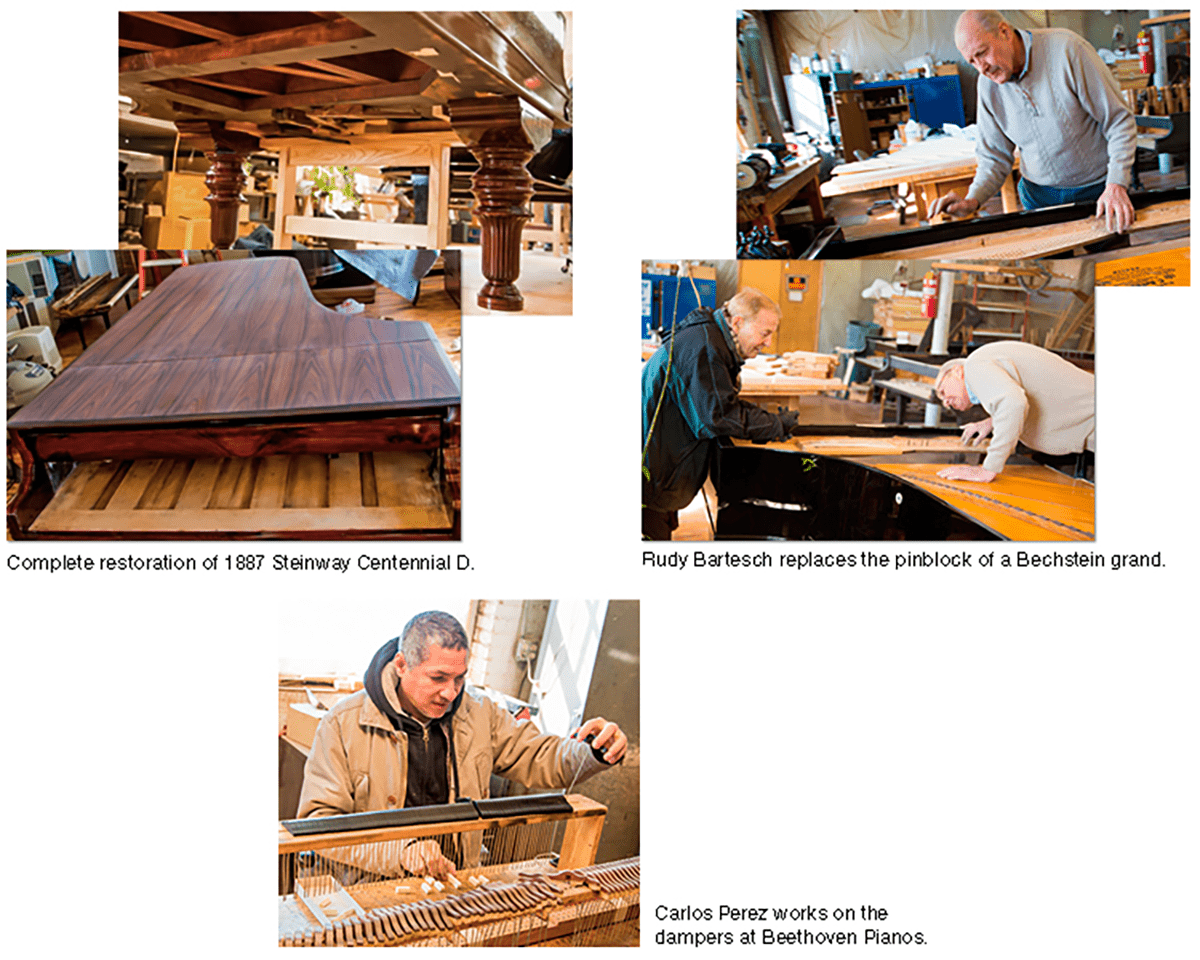
Faust Harrison Pianos
Manhattan Location
207 West 58th Street
New York, New York 10019
212-489-3600
www.faustharrisonpianos.com
Faust Harrison has been rebuilding pianos since 1983, when founder Sara Faust, a concert pianist, began rebuilding to satisfy her own need for high-quality performance instruments. What began as a hobby became a small side business, then quickly grew into a large enterprise as word spread of the availability of quality rebuilt Steinways. The business is now run by Sara, her husband, Irving, and their adult children, Joshua and Jessica, and has 32 full-time employees at its four locations in Manhattan, White Plains, and Huntington (Long Island), New York, and in Fairfield, Connecticut.
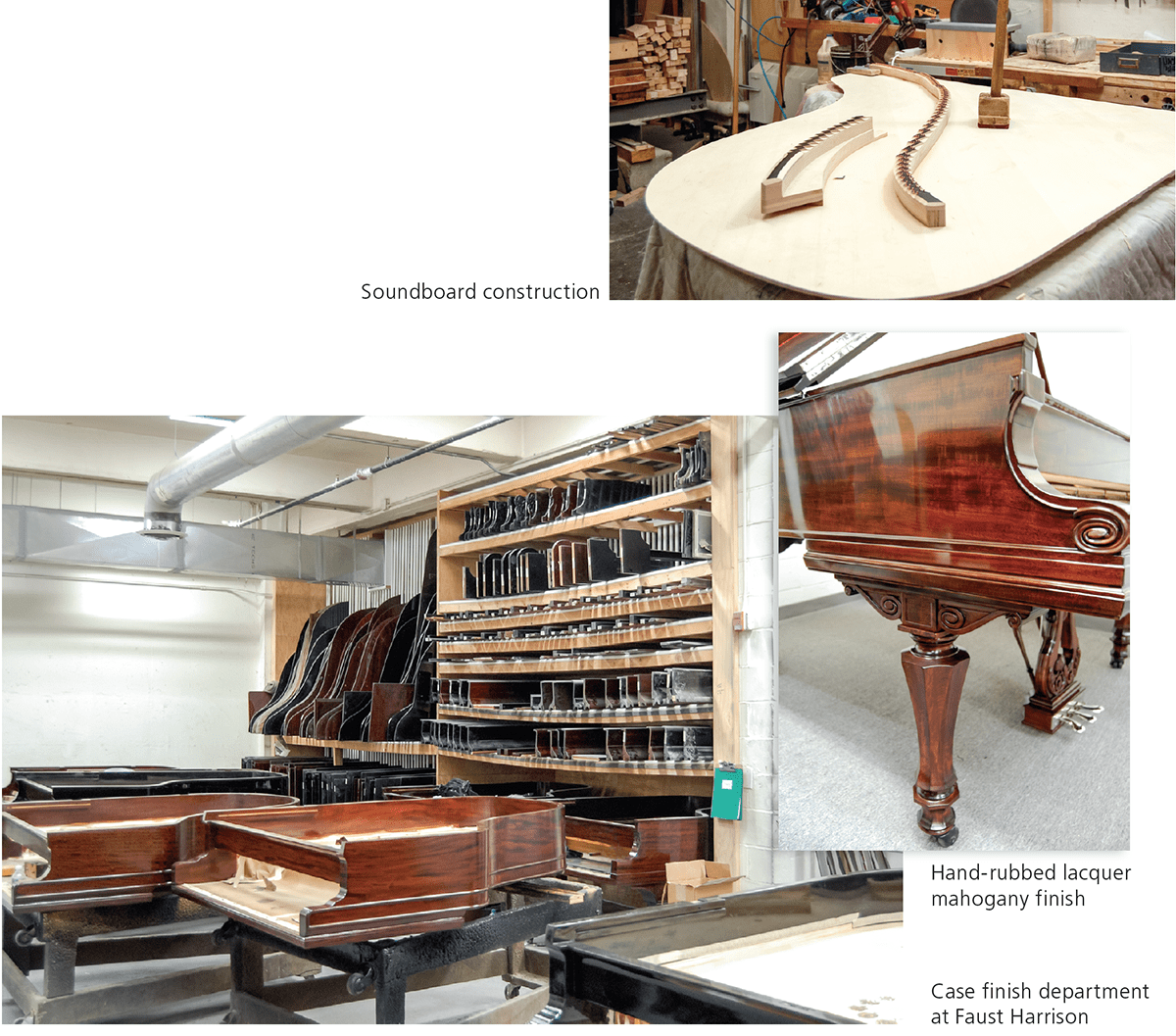
Their new, 25,000-square-foot facility in White Plains is designed especially for rebuilding, with careful consideration of humidity control and lighting, separation of woodworking from other departments, and a state-of-the-art dust-collection system to facilitate the high-quality refinishing for which they are especially known. Joshua Faust highlights their unusually extensive inventory, which includes used and rebuilt vintage-era Steinways and other fine makes. He says they source all their soundboard material from André Bolduc, the Canadian soundboard supplier, in the form of soundboard blanks, and craft every aspect of the soundboard themselves in their White Plains facility. The company rebuilds some 100 pianos per year, and maintains a few dozen completed rebuilt pianos in their four locations for customers to try. Faust Harrison also sells new C. Bechstein, Brodmann, W. Hoffman, Mason & Hamlin, Schimmel, and Yamaha pianos.
The special furniture page of their web site (www.faustharrisonpianos.com/brands/steinway-special-furniture-pianos.shtml) shows and describes two interesting Steinway Art Deco pianos restored by Faust Harrison. The first piano, built by Steinway in 1940 from a commissioned design by renowned designer Arthur Dorwin Teague, spent years on a cruise ship that sailed between New Orleans and Rio de Janeiro, where it suffered the effects of high humidity. It was fully rebuilt and refinished for a client by Faust Harrison in 2004, and has since been chosen to eventually join the keyboard collection of the Metropolitan Museum of Art. Irving Faust says he has seen several Teague-designed Steinways over the past 35 years, but has never seen another to match this piano's intriguing style.
In 2005, Faust Harrison acquired a 1938 Steinway Arts & Crafts model S piano that they were reluctant to rebuild because its case was rather ugly. However, they saw that, with a bit of ingenuity and some master carpentry, including the fabrication of an entire new leg-and-lyre assembly, they could transform the case to match that of Teague's Steinway Art Deco design.
In 2006, Hugh Grant, Drew Barrymore, and hordes of production crew descended on the Faust Harrison showroom on 58th Street to shoot a scene for the film Music and Lyrics. In 2007, Faust Harrison received a call from a woman in Ohio who was looking to buy a special-style Steinway S. Irving described the 1938 Arts & Crafts piano to her, as well as their vision of transforming it to look like the Teague Art Deco. The cost was more than she was looking to spend, but she was intrigued and said that she'd think about it. That evening, by coincidence, she took her niece to see Music and Lyrics — and there on the big screen was a shot of the Faust Harrison showroom. The next morning, she called to order the piano.
Klavierhaus
119 West 56th Street
New York, New York 10019
212-245-4535
www.klavierhaus.com
The background of Klavierhaus's Hungarian-born owner, Sujatri Reisinger, includes restoration work not only on modern pianos, but on antique European instruments as well. Although Klavierhaus focuses its rebuilding primarily on the larger Steinway models B, C, and D because of their extensive use as performance pianos, the company also rebuilds C. Bechstein, Blüthner, Bösendorfer, Broadwood, Érard, Pleyel, and other fine European makes. Reisinger feels that his company's strength lies in its ability to customize an action or sound to conform to the customer's preferences in touch and tone.
Klavierhaus has recently moved to a new location at Le Parker Meridien Hotel, where it hosts concerts to showcase its pianos. Klavierhaus is also the New York and New England retail outlet for Fazioli Pianoforti, the Italian maker of fine pianos. The Klavierhaus rebuilding workshop is in Yonkers, New York.
Klavierhaus associate Nicholas Russotto was generous with his enthusiasm and stories about famous pianists and their visits:
Last year, Klavierhaus performed some work on Emanuel Ax's Hamburg Steinway C, which, after decades of hard use, had begun to show the wear typical of a concert pianist's main practice instrument. Klavierhaus took in the piano and, after performing the requested maintenance, awaited Ax's arrival to try the repaired instrument. When he called to make an appointment to come into the shop, it turned out that another Klavierhaus client, concert pianist Richard Goode, had booked the recital hall at the same time to hear one of his students play. To accommodate Goode, Klavierhaus staff moved Ax's piano into the showroom, just outside the recital hall.
While trying out his piano, Ax played the first several measures of Beethoven's Sonata Op.81a, "Les Adieux," a beautiful piece with a somewhat wistful "horn call" in its first measures. The proper articulation of this passage requires a tremendously fine touch; the voicing of the horn call can be accomplished in multiple ways, and each pianist has his or her own way of doing so. During the course of the conversation with Klavierhaus staff, Ax asked who was in the recital hall, and was delighted to hear that it was his friend Goode. After toying a bit with the first moments of "Les Adieux," Ax jumped up from the bench and exclaimed, "Well, I'll just go ask the master!" He entered the recital hall, and from outside, the Klavierhaus staff heard each of them trying different voicings and articulations of the horn-call passage. They were thrilled to witness this interaction between two great figures of the piano world.
Klavierhaus has undertaken many difficult and unusual rebuilding projects, two of which are described below:
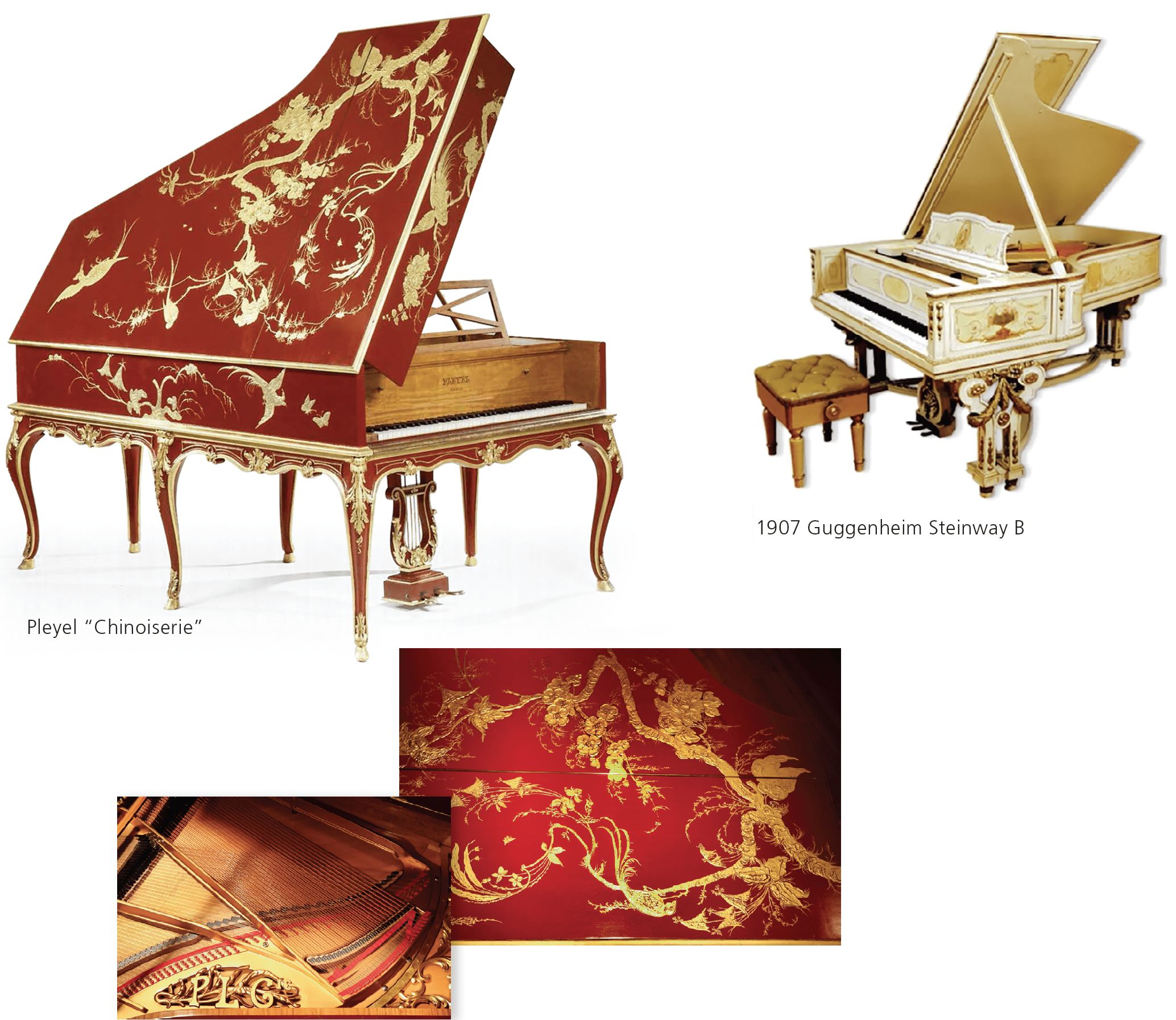
- The House of Pleyel was a powerhouse of harpsichord and piano building for much of the 19th and early 20th centuries. This Pleyel piano, dating from 1874, was installed in an ornate harpsichord case very much in the Louis XV "Chinoiserie" style: flowers, birds, and butterflies are depicted in 14-karat gold on a red background, and the case is supported by six legs that terminate in hoof sabots. The decorative restoration work was done by Nam Thai. The instrument has a lovely, exceedingly polite sound suitable for smaller spaces or salons. It has a completely new action, made to duplicate the touch of the original.
- This Steinway & Sons model B, from 1907, was purchased by William Guggenheim as a Valentine's Day gift for his wife. Custom-painted by Robert Benvenuti for Lucien Alavoine and Company (one of the firms contracted to refresh the Waldorf-Astoria hotel in the 1920s), it is a stunning, one-of-a-kind example of Louis XVI décor.
Lindeblad Piano Restoration
101 U.S. 46
Pine Brook, New Jersey 07058
888-587-4266
www.lindebladpiano.com
Lindeblad Piano Restoration is a family-owned business with six family members actively involved, in addition to other staff. It has been in business for more than 100 years, and rebuilds over 200 pianos a year. Lindeblad rebuilds all brands of upright and grand, both for sale and for private clients. At any time, more than 30 completed rebuilds are available to play at their shop. They offer a variety of warranty options on their sales of rebuilt pianos, including a 30-day guaranteed return policy.
Lindeblad maintains a strong online presence, including an inventory that can be browsed before visiting their showroom. The informative videos on their website thoroughly explain the quality of the work and their approach to issues that can come up in the rebuilding process, giving the consumer confidence in the quality of the finished product.
Below is a photo of a rare painted-case Steinway A recently restored by Lindeblad. The company worked with Fine Wood Conservation Ltd., an art-restoration facility in Brooklyn, New York, to restore the paintings on the case.
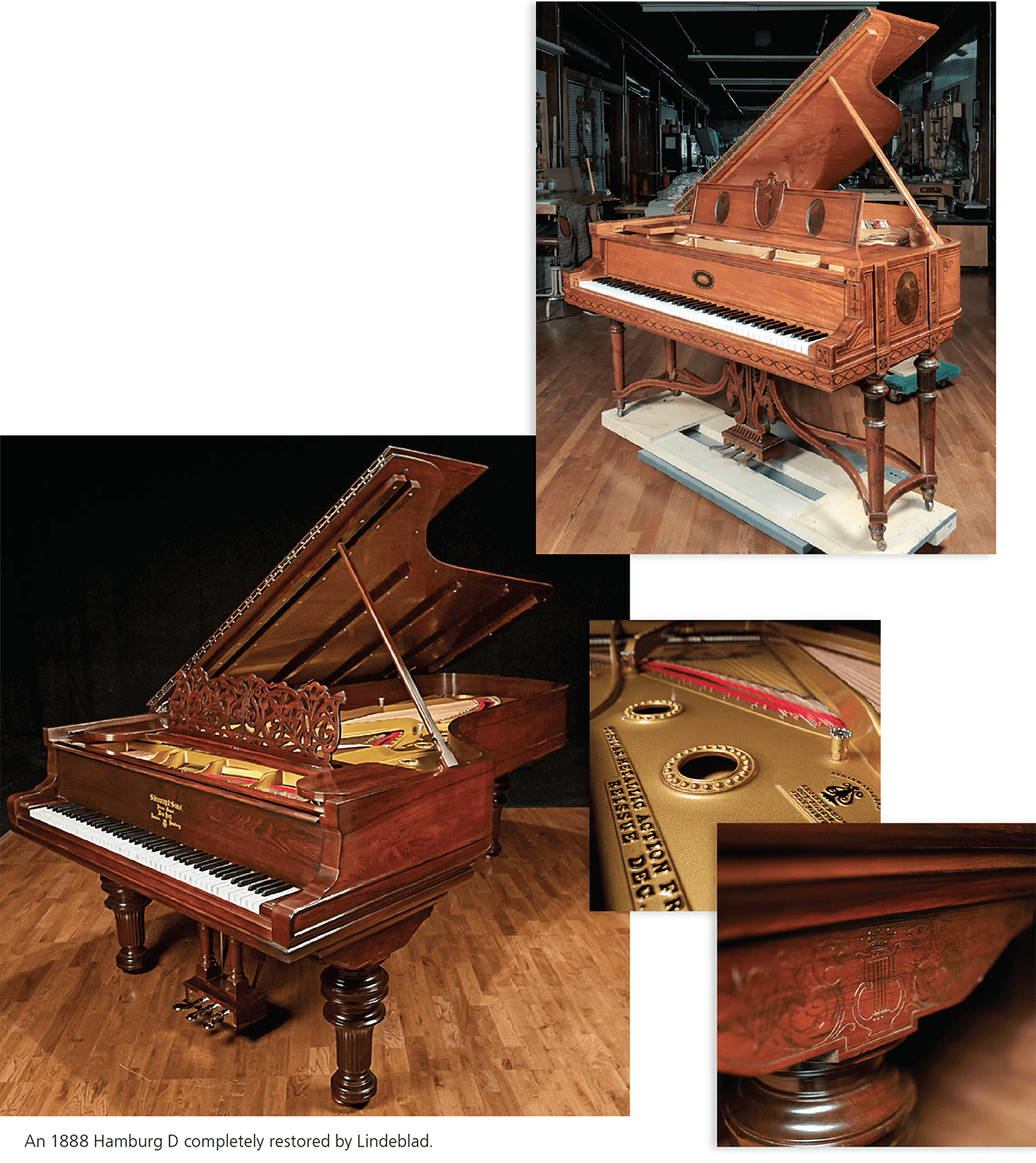
Steinway Restoration Center
Steinway & Sons
Steinway Place
Long Island City, New York 11105
718-204-3175
restoration.steinway.com
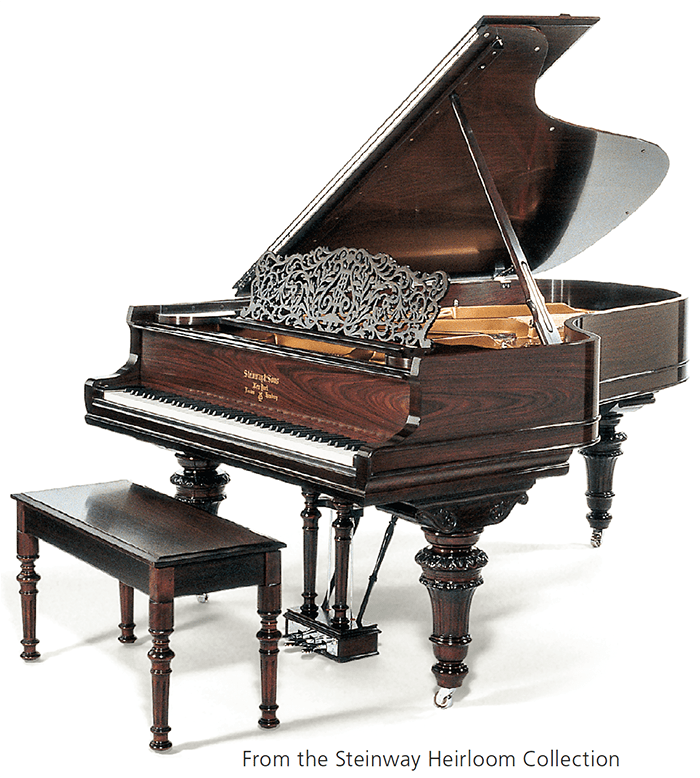
The Steinway Restoration Center, located at the Steinway & Sons factory in the Astoria section of Queens, New York, is engaged in three different areas of rebuilding. First, Steinway dealers contract with local clients to rebuild the clients' Steinway pianos, then send the pianos to the Restoration Center to have all or part of the work performed. Second, the Restoration Center rebuilds vintage-era Steinways and makes them available to Steinway dealers for resale. These pianos, known as the Steinway Heirloom Collection, are the only rebuilt Steinways for sale that are certified by Steinway & Sons as "100% genuine." Last, the Restoration Center contracts directly with private clients and institutions to rebuild their Steinway pianos. Steinway restores pianos for museums, concert halls, universities, and conservatories, including the Juilliard School and the Curtis Institute of Music. A Steinway piano rebuilt by the Restoration Center carries the same manufacturer warranty as a new Steinway. The company works with Steinway dealers and technicians all over North and South America to arrange shipment to and from the factory for these services. The pianos are insured from pick up to return, and include the resources available to Steinway dealers for follow-up tuning and maintenance.
In addition to rebuilding a piano's innards, Steinway has extensive resources for refinishing exterior cases, and, upon request, can work in traditional finishes such as hand-rubbed lacquer, varnish, or French polish, as well as the current standard high-polish polyester finish. The Restoration Center also employs the services of several specialty woodcarvers who can reproduce damaged or missing carvings or art work, as well as moldings, legs, music desks, or other case parts.
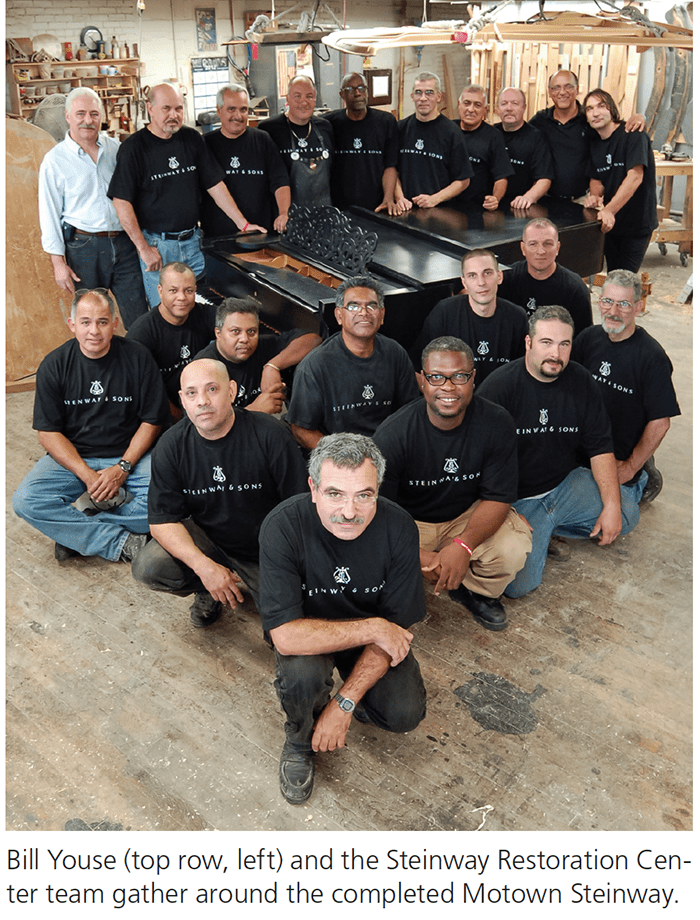
Bill Youse, a 40-year, third-generation Steinway employee, supervises the Restoration Center's 25 dedicated specialists. Many of these senior craftsmen have 30 to 40 years' experience at Steinway. They do well over 100 restorations a year, all Steinways. As the head of the Restoration Center, Youse is not only an expert in the mechanics of the piano, but has a wealth of knowledge about the historic case styling and rare woods used, now and in the past.
Youse recalls the opportunity in 2012 to restore the 1877 Motown Museum Steinway. Sir Paul McCartney had contacted Steinway to ask if they would work with him to see that the famous Steinway used in so many recordings at Motown was restored to its former glory. The piano had been in constant use for decades, and the repairs it received during that time had been a creative combination of conservation and keeping the piano functioning. Several attempts at partial rebuilding had been made to this early Steinway, and the resulting functionality would not have been optimal for any piano, much less for a Steinway. The Motown Museum wanted the instrument brought back to its original working order, but also wanted to keep the worn and battered case. After several meetings of Museum conservators with the Steinway Restoration Center, a plan was completed and agreed on, and the rebuilt piano was returned to Detroit in late 2012. 
